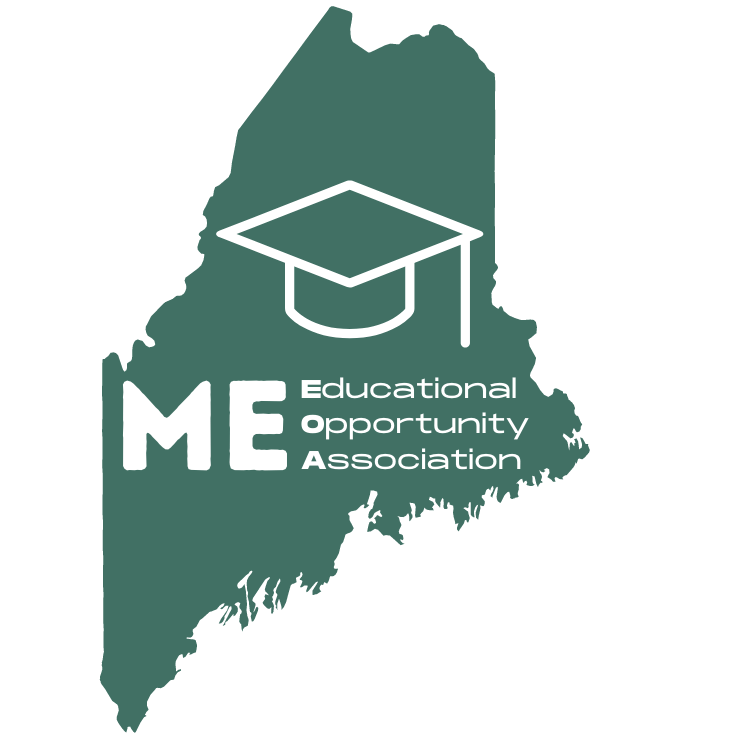|
THE MAINE EDUCATIONAL
OPPORTUNITY ASSOCIATION
"PROGRAMS THAT WORK"
Teresa Smith, President
tsmith@kvtc.net
453-5013
THE PROGRAMS
GEAR
UP: Currently one
state program and one partnership program serve over 4500 students per year. GEAR UP
ties universities, school districts and communities together to promote
educational opportunities and creates long-lasting changes in K-16 education.
- Maine State GEAR
UP - Provides services at high-poverty
middle and high schools. GEAR UP funds are also used to provide college
scholarships to low-income students.
- UMF GEAR UP Partnership
Program - Serves
students at Dirigo Middle School and Dirigo High School. Partnership programs
provide a unique opportunity for early intervention and systemic change
for schools.
Maine
TRIO Programs: Currently 18 TRIO projects serve 6,430 students in Maine.
- Educational
Opportunity Centers – Help primarily low-income adults who would be first generation
college students gain admission to college and find financial assistance
for their education.
- Student Support
Services –
Help low-income and first-generation college students and individuals with
disabilities graduate from college.
- Talent Search – Identifies, prepares and
assists students in grades six through twelve with applying for financial
aid and college admission.
- Upward Bound – Prepares high school
students for success in postsecondary education.
- Upward Bound
Math/Science –
Prepares high school students for college programs that lead to careers in
math and science.
Evidence of Success
- Survey results show a majority
of students at Dirigo High School are planning to go to college (94.5% of
high school freshmen, and 74.3% of sophomores).
- 72.4% of academically prepared
EOC adults enroll in college each year.
- Students in the Student
Support Services program are more than twice as likely to remain in
college than those students from similar backgrounds who did not
participate in the program.
- 86.6 % of Talent Search
graduating seniors enroll in college.
- Students in the
Upward Bound program are four times more likely to earn an undergraduate
degree than those students from similar backgrounds who did not
participate in TRIO.
What makes these
programs so successful?
Performance
Based
Each program operates against specific, measurable outcome objectives as
clearly defined in each approved grant proposal. Program directors are held
accountable and must meet their stated objectives each year if they expect to
remain funded and able to help participants in their targeted service area.
Focused on Early Intervention
Three of the programs, GEAR UP, Talent Search and Upward Bound, are early
intervention programs. These programs effectively reach students in grades six
through twelve who have "college potential" but often do not
recognize or understand their academic and career options beyond high school.
Targeted Toward First-Generation and Low-Income
The majority of students in the programs come from families with incomes under
$24,000, where neither
parent
graduated from college. In most cases, parents have no higher education
experience, do not understand the postsecondary process and do not necessarily
value a higher education.
Built
on Relationships
Over a period of several months or years, professionals build both personal and
professional relationships with their students. Such positive relationships are
critical to the success of every program. The staff of each program creates a
climate of support for students as they strive to move out of poverty and
dependence.
Committed to Tough Cases
In most cases, students in the programs are poor and are desperately trying to
climb out of "the vicious cycle of poverty in America." A single
parent raising several children, an older child helping to raise younger
siblings, a physically-disabled person with few financial resources and a
struggling high school student trying to escape a life of poverty describe the
young people and adults who turn to the programs for help and special
assistance.
Consistent and Intense
The programs and the professionals are consistently available to their
students. In fact, some programs enable students to meet with counselors during
the summer, in the evening, on weekends, or at home.
Comprehensive and Cultural
The services administered through the programs are comprehensive and must go
far beyond the traditional services offered by high school or college
counselors. Many students receive instruction in literature, composition,
foreign languages, mathematics and science. In addition, students receive
assistance in completing college admission and financial aid applications,
tutorial services and exposure to cultural events.
Community Based
Community need is determined by the community, not the federal government.
Funding is based on clear evidence that the program is needed in a particular
community or town.
What is the need?
Maine
has large numbers of low income people. 22% or 75,644 live at or below 150% of the poverty level. (US Census Bureau 2000)
77%
of individuals aged 25 or over in Maine DO NOT have a college degree. Maine has slipped from 26th to 38th in the percentage of adults with a 4-year degree. (US Census
Bureau 2000 and Maine Center for Economic Policy)
Only
66% of 2001 Maine high school graduates enrolled in college the following
fall. (Maine Department of
Education)
Students
from families whose parents did not attend college score significantly lower on
the Maine Educational Assessment than students whose parents are college
educated. (Maine Department of Education)
Current funding levels
allow Educational Opportunity Programs in Maine to help less than 10% of those
individuals eligible for their services.
|

